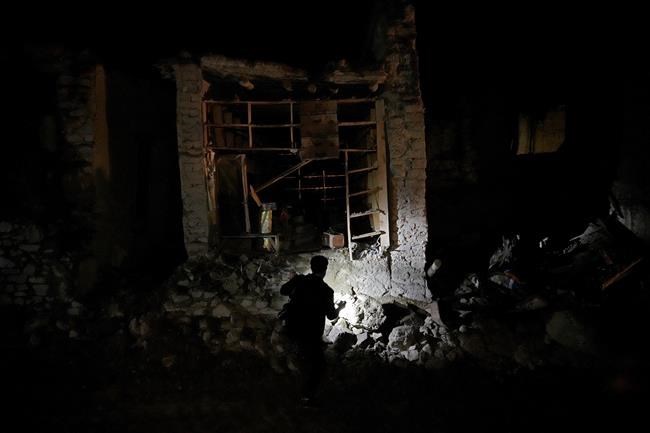GAYAN, Afghanistan (AP) — A powerful earthquake struck a rugged, mountainous region of eastern Afghanistan early Wednesday, flattening stone and mud-brick homes and killing at least 1,000 people. The disaster posed a new test for Afghanistan’s Taliban rulers and relief agencies already struggling with the country’s multiple humanitarian crises.
The quake was Afghanistan’s deadliest in two decades, and officials said the toll could rise. An estimated 1,500 others were reported injured, the state-run news agency said.
The disaster inflicted by the 6.1-magnitude quake heaps more misery on a country where millions face increasing hunger and poverty and the health system has been crumbling since the Taliban retook power nearly 10 months ago amid the U.S. and NATO withdrawal. The takeover led to a cutoff of vital international financing, and most of the world has shunned the Taliban government.
In a rare move, the Taliban’s supreme leader, Haibatullah Akhundzadah, who almost never appears in public, pleaded with the international community and humanitarian organizations “to help the Afghan people affected by this great tragedy and to spare no effort."
Residents in the remote area near the Pakistani border searched for victims dead or alive by digging with their bare hands through the rubble, according to footage shown by the Bakhtar news agency. It was not immediately clear if heavy rescue equipment was being sent, or if it could even reach the area.
At least 2,000 homes were destroyed in the region, where on average every household has seven or eight people living in it, said Ramiz Alakbarov, the U.N. deputy special representative to Afghanistan.
The full extent of the destruction among the villages tucked in the mountains was slow in coming to light. The roads, which are rutted and difficult to travel in the best of circumstances, may have been badly damaged, and landslides from recent rains made access even more difficult.
Rescuers rushed in by helicopter, but the relief effort could be hindered by the exodus of many international aid agencies from Afghanistan after the Taliban takeover last August. Moreover, most governments are wary of dealing directly with the Taliban.
In a sign of the muddled workings between the Taliban and the rest of the world, Alakbarov said the Taliban had not formally requested that the U.N. mobilize international search-and-rescue teams or obtain equipment from neighboring countries to supplement the few dozen ambulances and several helicopters sent in by Afghan authorities. Still, officials from multiple U.N. agencies said the Taliban were giving them full access to the area.
The quake was centered in Paktika province, about 50 kilometers (31 miles) southwest of the city of Khost, according to neighboring Pakistan’s Meteorological Department. Experts put its depth at just 10 kilometers (6 miles). Shallow earthquakes tend to cause more damage.
The European seismological agency said the quake was felt over 500 kilometers (310 miles) by 119 million people across Afghanistan, Pakistan and India.
Footage from Paktika showed men carrying people in blankets to a waiting helicopter. Other victims were treated on the ground. One person could be seen receiving IV fluids while sitting in a plastic chair outside the rubble of his home, and still more were sprawled on gurneys. Some images showed residents picking through clay bricks and other rubble. Roofs and walls had caved in.
The death toll reported by the Bakhtar news agency was equal to that of a quake in 2002 in northern Afghanistan. Those are the deadliest since 1998, when an earthquake that was also 6.1 in magnitude and subsequent tremors in the remote northeast killed at least 4,500 people.
Wednesday’s quake took place in a region prone to landslides, with many older, weaker buildings.
“The fear is that the victims will increase further, also because many people could be trapped under collapsed buildings,” said Stefano Sozza, Afghanistan country director for the Italian medical aid group Emergency, which sent seven ambulances and staff to areas near the quake zone.
More than 60% of Afghanistan’s population of 38 million already relies on international aid to survive.
Humanitarian agencies still operating in the country, including UNICEF, rushed supplies to the quake-stricken areas. And Pakistan said it would send food, tents, blankets and other essentials.
Obtaining more direct international help may be more difficult: Many countries, including the U.S., funnel humanitarian aid to Afghanistan through the U.N. and other such organizations to avoid putting money in the Taliban’s hands.
The quake “will only add to the immense humanitarian needs in Afghanistan, and it really has to be all hands on deck to make sure that we really limit the suffering that families, that women and children are already going through,” said Shelley Thakral, spokesperson for the the U.N. World Food Program in Kabul.
In the capital, Prime Minister Mohammad Hassan Akhund convened an emergency meeting at the presidential palace.
“When such a big incident happens in any country, there is a need for help from other countries,” said Sharafuddin Muslim, deputy minister of state for disaster management. “It is very difficult for us to be able to respond to this huge incident.”
That may prove difficult given the international isolation of Afghanistan under the Taliban, who were toppled from power by the U.S. in the wake of the 9/11 attacks. The newly restored government has issued a flurry of edicts curtailing the rights of women and girls and the news media in a turn back toward the Taliban’s harsh rule from the late 1990s.
“This does add a lot to the daily burden of survival,” the U.N.’s Alakbarov said of the quake. “We are not optimistic today.”
___
Associated Press writers Rahim Faiez and Munir Ahmed in Islamabad and Jon Gambrell and Isabel DeBre in Dubai, United Arab Emirates, contributed to this report.
Ebrahim Noroozi, The Associated Press




